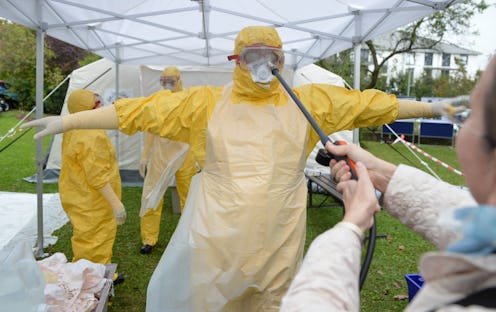News
Exactly How Contagious Is Ebola?
On Wednesday, the first Ebola patient diagnosed inside the United States, Thomas Eric Duncan, passed away from the disease. Duncan's exposure to roughly 80 people prior to his isolation sparked panic (including 5,000 false alarms), but medical professionals at the hospital seemed confident, and media organizations were downright snarky about those reactions. Still, with a disease that's killed 70 percent of those infected in West Africa, panicked reactions are nothing to scoff at. And just how contagious is Ebola, anyway?
In the eyes of doctors, the panic is largely unwarranted. "I'm more worried that somebody would be texting worrying about Ebola and then have a car crash because they were not paying attention to their driving," Dr. Rex Archer told Kansas City's KMBC.
As NPR reported last week, R0 (pronounced "R naught") is a mathematical term that tells us how contagious an infectious disease is. The R0 tells us how many people get infected from one sick person during an outbreak, and for Ebola the R0 hovers around 1.5 to 2.
If that sounds like a lot, it should be noted that there are many factors that tie into the R0 rate, namely the time that the infected person is out among other people and untreated. In developing countries, exposure poses a serious medical risk, but a developed nation's medical system ensures the threat can be easily and quickly contained. And what about other diseases' R0 scores?
Severe Acute Respiratory Syndrome (SARS)
SARS has an R0 of 4, which means that each person infected with SARS is likely to infect four other people. In the early 2000s, a SARS outbreak in Asia put the U.S. at high alert, although there were no domestic deaths reported. Unlike Ebola, SARS is an airborne virus, which might account for why people infected with SARS are expected to infect twice as many people. WHO reported that SARS has a fatality rate of 9.6, significantly behind Ebola.
Mumps
Those infected with mumps will spread it, on average, to 10 other people. Though there are common vaccines for mumps, there was a 2009-2010 outbreak of the virus in the U.S. The disease is rarely fatal, about 1 in 10,000 cases according to WHO.
Measles
Measles is a highly contagious viruses, with an R0 of 18. That means that measles are over four times as contagious as Ebola. Before widespread vaccinations, in 1980, measles caused around 2.6 million deaths per year.
Flu
Health officials prep for flu season each year, which kills thousands in the U.S. annually. With the flu, unlike Ebola, people can spread the virus without ever having direct contact with others. Even though the R0 is low, the rate of infection is very high because it is an airborne virus and strains are already pervasive in the U.S. Each year, 5 to 20 percent of the U.S. population gets the flu, and it hospitalizes over 200,000.
So, the moral of the story? Be more worried about getting a flu shot than the Ebola virus.
Images: Getty Images (5)
